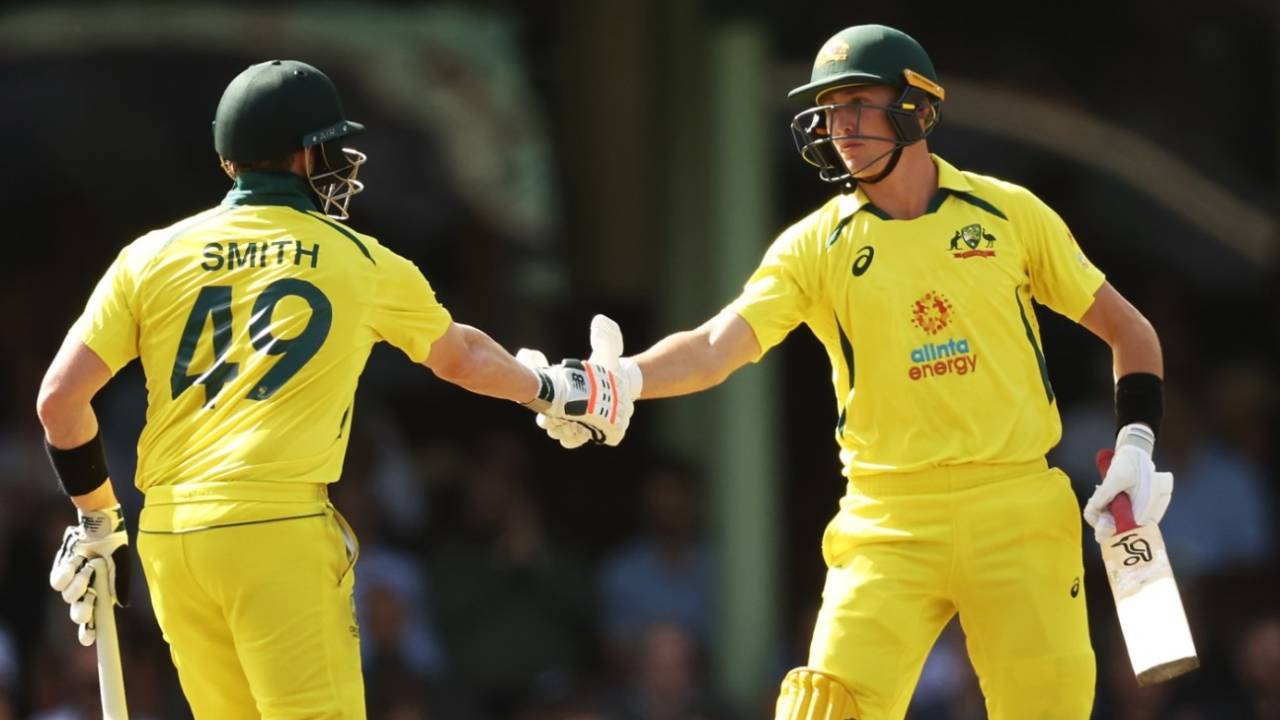Questions for Australia: how many allrounders are too many in an ODI XI?
The visitors will use the upcoming three ODIs to find answers for the World Cup in India later this year
Andrew McGlashan
16-Mar-2023
Is there place for Marnus Labuschagne in Australia's ODI XI with Steven Smith at No. 3? • Getty Images
With the ODI World Cup taking place in India during October and November, the upcoming three matches are a valuable chance for Australia to work through some plans and tactics. They do have more matches, against South Africa in late August, before having to name a squad but this series will give them a good handle on conditions. Here are a few issues that need to be determined before the tournament.
How many allrounders?
Last year, Australia experimented with a deep batting order that at times had either Cameron Green or Glenn Maxwell come in at No. 8. Maxwell has put together a terrific run at No. 7, where he averages 48.10 with a strike-rate of 123.33 since 2020. In the early stages if his ODI career, Green has also played valuable innings lower down the order, most notably the match-winning 89 not out against New Zealand. It's a combination that could be on show again in India as the selectors determine whether it will be worth using at the World Cup. Mitchell Marsh (who won't bowl in this series), Marcus Stoinis also fall into the batting-allrounder category while Sean Abbott and Ashton Agar are bowling allrounders. The theory of a deep batting order is that if matches are dominated by the bat, the impact of the extra batting will outweigh what a specialist bowler would bring and provide the power to either set or defend a target.Does Marnus Labuschagne fit in?
Australia's top three will be David Warner, Travis Head and Steven Smith, but after that there might be some room for shuffling, depending on how many allrounders play. Marnus Labuschagne made his ODI debut in India in early 2020 and had a promising start with a century and two fifties in his first six innings. Overall he now averages 32.16 with a strike-rate of 84.54 and there has been the question raised as to whether having him and Smith at No. 3 and 4 is the best fit. The value of having two Test batters in those roles was shown against New Zealand in Cairns last September when the ball was zipping around for Trent Boult and Tim Southee. They added 116 to set up Australia's victory. However, it's unlikely the ball will be doing much zipping at the World Cup. Labuschagne's bowling has also faded.Is there a place for Josh Inglis?
Alex Carey is the incumbent ODI wicketkeeper and has a good record in the format. Against New Zealand last year he and Green added 158 for the sixth wicket to transform a chase from the depths of 44 for 5. However, Josh Inglis - a dynamic, versatile batter solid with the gloves - is nipping at Carey's heels. In the recent Marsh Cup final, he made 138 off 110 balls and his overall List A strike-rate is an impressive 112.97. There's a strong chance he will play a utility role in the World Cup squad, providing both batting and wicketkeeping cover, but there is a case to be made that he is worthy of a place in the starting XI.
Josh Hazlewood, Pat Cummins, Mitchell Starc - all three may not play together in ODIs•Getty Images
Can Maxwell be the second spinner?
Maxwell is still on the comeback trail from the badly-broken leg he suffered in November but it is hoped he can play a reasonably significant role with the ball. He will likely have a vital part to play in the World Cup. In 2019 and 2020 he went 13 matches without taking an ODI wicket, but he has developed his offspin significantly over the last few years. He took 4 for 52 against New Zealand in Cairns in September and sent down his full complement of 10 overs in four matches last year. Agar is the other frontline spinner in the squad but his ODI record is less impressive than his T20I returns.
Opportunity for Sean Abbott and Nathan Ellis
Both Abbott and Ellis can consider themselves unlucky not to have played more for Australia. With neither Josh Hazlewood or Pat Cummins available against India there could be an opening for one if not both of them. Although not like-for-like players - Abbott offers more with the bat - they may be battling for one spot at the World Cup. Abbott was outstanding against New Zealand last year, sending down a remarkable spell of 5-4-2-1 in the second match. Ellis, meanwhile, who replaced Jhye Richardson in this squad, has made an excellent start to his T20I career and had a strong case to be the T20 World Cup squad.
Mitchell Starc, Pat Cummins, Josh Hazlewood: two out three?
In relation to fast bowlers (and again the allrounder debate), it looks difficult for Australia's Big Three to play in the same XI. It won't be resolved in this series with two of them unavailable, but the balance of the side could give an insight. Cummins has been earmarked for the World Cup captaincy and Mitchell Starc is a white-ball great. That leaves Josh Hazlewood, who is also an outstanding limited-overs bowler, facing being forced out of the XI. It's also interesting to ponder whether there is a scenario where, even as captain, Cummins does not play every game in the World Cup.
Andrew McGlashan is a deputy editor at ESPNcricinfo
